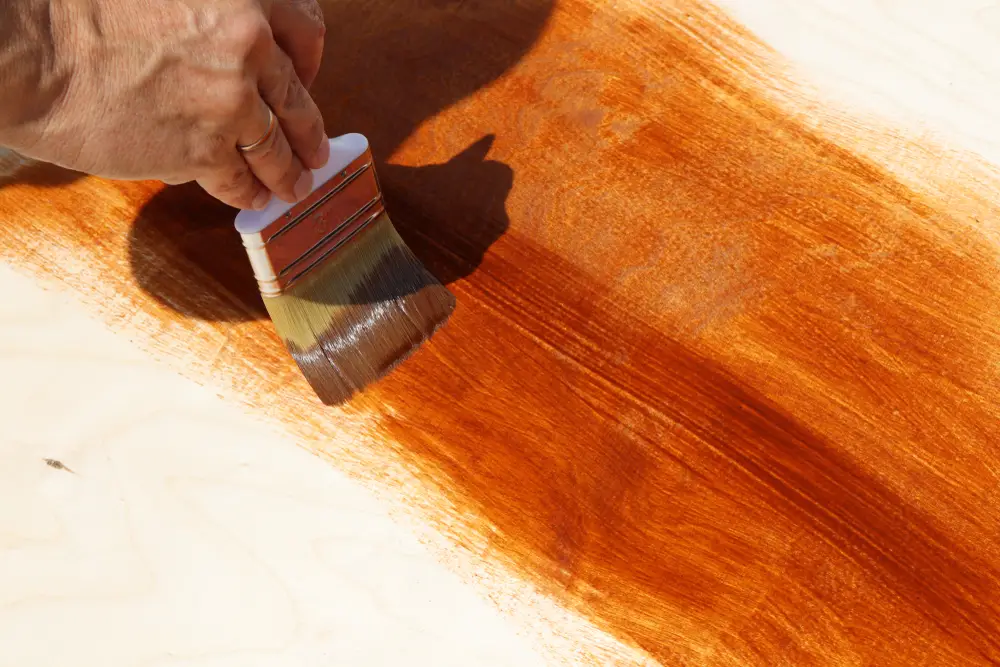How Much Wood (Exactly) Is Required For A Door?
The amount of wood required for a standard residential door is typically 10-20 board feet or approximately 3-6 cubic feet of wood, but can vary based on size, type, design features, and materials used. More intricate custom doors can require 10+ cubic feet of wood.
This guide will break down the typical wood requirements for different door types to help you understand exactly how much raw material is needed for your project.
Standard Interior Doors
Most interior doors in homes and offices are either 24, 28, 30, or 36 inches wide. Standard heights range from 80 to 96 inches. Thickness generally falls between 1-3/8 to 1-3/4 inches. The most common interior door styles are:
- Flush doors – Flat panel design constructed with a wood frame and hollow or solid wood core.
- Paneled doors – Decorative grooves and indentations on the face. Traditional styles include two, four, and six panel designs.
- French doors – Paired doors with large glass panes surrounded by wood framing.
On average, a standard 1-3/8 inch thick, 80 inch high, 30 inch wide flush interior door requires:
- Framing – 8 board feet of wood
- Veneer – 10-20 square feet
- Core material – 15 pounds of wood, particleboard, or MDF
So in total, a typical 30″ interior door can use around 8-10 board feet of wood.
Table 1. Estimated wood required for standard interior doors
| Door Size | Framing | Veneer | Core | Total Wood |
|---|---|---|---|---|
| 24″ x 80″ | 5 bf | 8 sf | 10 lbs | 5-7 bf |
| 28″ x 80″ | 6 bf | 10 sf | 12 lbs | 6-8 bf |
| 30″ x 80″ | 8 bf | 12 sf | 15 lbs | 8-10 bf |
| 36″ x 80″ | 10 bf | 15 sf | 20 lbs | 10-12 bf |
Extra wide or specialty interior doors that feature decorative glass, carvings, arched tops, or wider dimensions can require additional wood materials.
Entry Doors
Front doors bear the brunt of weather and wear, so they need to be more rugged than interior versions. Common types of entry doors include:
- Solid wood – Constructed from high-quality hardwoods like oak, mahogany, and walnut. Typically 1-3/4 to 2 inches thick. Offers maximum durability.
- Steel – Metal doors with insulation provide security. Can have wood veneer or other coverings.
- Fiberglass – Durable in any climate. Often have realistic wood grain texture.
- Glass – Allow natural light inside. Usually have some wood framing.
On average, a standard 80 inch high, 36 inch wide exterior entry door requires:
- Framing – 15 board feet of wood
- Veneer – 25 square feet
- Core – 40 pounds of wood or engineered material
- Total – 15-20 board feet of wood
So front doors need about twice as much framing lumber as interior versions, but have comparable veneer and core requirements. Specific designs can require much more:
- Solid mahogany doors = 25+ board feet
- Full lite glass doors = 30+ board feet
- Custom carved doors = 50+ board feet
Table 2. Estimated wood required for standard exterior entry doors
| Door Size | Framing | Veneer | Core | Total Wood |
|---|---|---|---|---|
| 30″ x 80″ | 10 bf | 15 sf | 25 lbs | 10-15 bf |
| 36″ x 80″ | 15 bf | 25 sf | 40 lbs | 15-20 bf |
| 36″ x 96″ | 20 bf | 30 sf | 50 lbs | 20-25 bf |
So while a basic hollow core exterior door may only need 15 or so board feet of wood, upgraded solid wood and custom versions can require much more material.
Garage Doors
Given their large size, garage doors need to be carefully engineered to be lightweight yet durable. Most designs utilize steel, fiberglass, or vinyl skins over a foam insulation core. But wood can still be found in:
- Carriage house style – Hardwood panels give the look of old swinging doors. Require significant wood.
- Custom wood doors – Durable and decorative. Require 50+ board feet.
- Wood overlay doors – Steel doors with thin hardwood veneers. Require minimal wood.
On average, a 16×7 foot single car garage door requires:
- Framing – 10 board feet
- Veneer – 50-100 square feet
- Total – 10-15 board feet
And a larger 18×7 foot two car garage door requires:
- Framing – 15 board feet
- Veneer – 75-150 square feet
- Total – 15-20 board feet
But custom or all-wood carriage style doors for two car garages can require 100+ board feet of lumber.
Table 3. Estimated wood required for garage doors
| Door Size | Framing | Veneer | Total Wood |
|---|---|---|---|
| 9×7 (single) | 5 bf | 25-50 sf | 5-10 bf |
| 16×7 (single) | 10 bf | 50-100 sf | 10-15 bf |
| 18×7 (double) | 15 bf | 75-150 sf | 15-20 bf |
So unless you select a specialty wood design, the amount of lumber needed for a typical steel or fiberglass garage door is quite minimal compared to other exterior door types.
Sliding and French Doors
Another exterior door option are sliding and French door styles utilizing multiple panels and glass to open up spaces. On average:
- 6′ sliding patio door – 15 board feet
- 6′ French door – 20 board feet
- 8′ sliding patio door – 20 board feet
- 8′ French door – 25 board feet
The extended horizontal dimensions of these doors require additional framing and structural support from wood compared to standard hinged doors. But much less than swinging French door designs.
Table 4. Estimated wood required for sliding and French doors
| Door Type and Size | Total Wood |
|---|---|
| 6′ Sliding Patio Door | 15 bf |
| 6′ French Door | 20 bf |
| 8′ Sliding Patio Door | 20 bf |
| 8′ French Door | 25 bf |
Barn Doors
Barn doors have become popular for certain rustic or industrial interior designs. These very wide sliding doors are suspended from an overhead track system. On average:
- 3′ barn door – 10 board feet
- 4′ barn door – 15 board feet
- 6′ barn door – 25 board feet
The minimal framing and wide panel design require significant amounts of wood compared to standard doors. And optional hardware, handles, and custom designs can increase lumber needs.
Table 5. Estimated wood required for barn doors
| Barn Door Size | Total Wood |
|---|---|
| 3′ | 10 bf |
| 4′ | 15 bf |
| 6′ | 25 bf |
So unless you want a smaller closet door, expect to need upwards of 15+ board feet of wood for most barn door projects.
Door Frames
Beyond the doors themselves, the framing and trims involved in installations also require additional wood materials, including:
- Jambs – Vertical door frame components. Up to 5 board feet each.
- Headers – Horizontal top frame section. Up to 10 board feet.
- Casings – Decorative door trim. Up to 20 linear feet.
- Stops – Strips securing door edges. Up to 15 linear feet.
So for a typical interior door setup, you may need:
- 2 jambs – 10 board feet
- 1 header – 10 board feet
- Casings – 20 linear feet
- Stops – 15 linear feet
And a wider exterior door with brick molding may require:
- 2 jambs – 10 board feet
- 1 header – 15 board feet
- Casings – 25 linear feet
- Stops – 25 linear feet
- Brick molding – 25 linear feet
This can add over 15+ board feet of additional wood depending on door sizes and designs.
Specialty & Custom Door Considerations
Several other door types and custom designs can have increased wood needs:
- Arched/radius doors – Require fabricated curved framing.
- Dutch doors – Two door segments double framing.
- Pocket doors – Hidden sliding type needs framed cavity.
- Tall doors – Over 8 feet require additional structural framing.
- Wide doors – Over 4 feet require heavier framing.
- Curved doors – Bent lamination fabrication methods.
- Carved doors – Intricate designs need high quality wood.
- Multi-lite doors – More framing around glass panels.
- Inlaid doors – Cutout designs need solid panel cores.
- Old growth wood – More dense and stable backyard trees needed.
So if you want anything beyond a standard rectangular door with basic jambs and trims, expect your wood requirements to increase significantly.
Factors Impacting Lumber Requirements
Several other factors beyond just door type and size can influence the amount of wood needed:
- Material thickness – Thicker wood requires more board feet.
- Wood species – Density and yields vary.
- Door design – More details need more wood.
- Core material – Solid wood vs engineered options.
- Jamb details – Simple vs complex trimwork.
- Hardware – Standard vs custom fancy handles and hinges.
- Weatherproofing – Exterior doors may need edge sealing.
- Finish level – More carved areas need more sanding and detail.
- Hanging method – Mortise and tenon vs basic butts.
- Quality level – Grades of lumber and material cuts.
The more customized, intricate, and durable you want your door, the more wood craftsmanship and materials will be required during fabrication and installation.
Average Wood Required by Door Type
Based on standard sizes and designs, here are the average board feet of lumber required by different door types:
Table 6. Average wood required by door type
| Door Type | Average Wood Needed |
|---|---|
| Interior Flush | 8 bf |
| Interior Paneled | 10 bf |
| Interior French | 15 bf |
| Exterior Entry | 20 bf |
| Exterior Glass | 25 bf |
| Sliding Patio | 20 bf |
| French Patio | 25 bf |
| Wood Garage | 50+ bf |
| Barn Door | 15 bf |
These material estimates provide a rough guideline, but the actual amount can vary based on your specific project details. Contact a qualified wood door manufacturer or installer for a more accurate quote based on the designs and features you want.
Average Costs of Wood Doors
The amount of wood required influences both material costs and overall project expenses. Here are typical price ranges for various wooden door types:
- Interior flush – $75 to $300
- Interior French – $400 to $1000
- Exterior entry – $250 to $2000
- Sliding patio – $600 to $1500
- French patio – $800 to $3000
- Wood garage doors – $800 to $4000
- Custom wood doors – $1500+
Prices depend on factors like door size, wood type, design details, hardware options, and labor. Expect premium exotic hardwoods, intricate carvings, and custom engineering to boost costs.
How Much Wood Do You Actually Need?
Determining your specific wood needs involves considering:
- What types of doors are you installing? Interior, exterior, garage, etc.
- What are the dimensions of each door? Width, height, and thickness.
- What kinds of designs do you want? Flush, paneled, lite, arched, etc.
- What materials will be used? Solid wood, veneer, engineered cores, etc.
- Will door frames, trims, and moldings also need wood?
- Do you want any custom decorative details or carvings?
- What species of wood is best for the application? Hardness, durability, and appearance.
- Does everything need to match existing doors or trims?
Add up the rough board foot estimates for each component based on your particular project. Then add at least 10% extra to allow for imperfect cuts, potential damage, and customization flexibility. Apply that total to the material quotes from your chosen lumber supplier or door manufacturer to get an accurate estimate of exactly how much wood you will require.
Key Takeaways – How Much Wood for a Door?
- Standard interior doors need 5-10 board feet of wood.
- Exterior entry doors average 15-20 board feet.
- Garage doors have minimal wood unless custom styles.
- Sliding patio doors require 15-25 board feet.
- French door designs need 20-30+ board feet.
- Barn doors can use over 15 board feet.
- Door frames, jambs, and trims add 10-20+ more board feet.
- Custom doors and specialty types require significantly more wood.
- Hardwood species, thickness, and construction quality impact lumber amounts.
- Accurately estimate your needs based on all door types, sizes, and design features.
Knowing these typical material requirements provides a valuable starting point for planning any door construction or installation project using wood. Just be sure to factor in your exact specifications and any custom elements in order to determine the precise board foot lumber needs.




